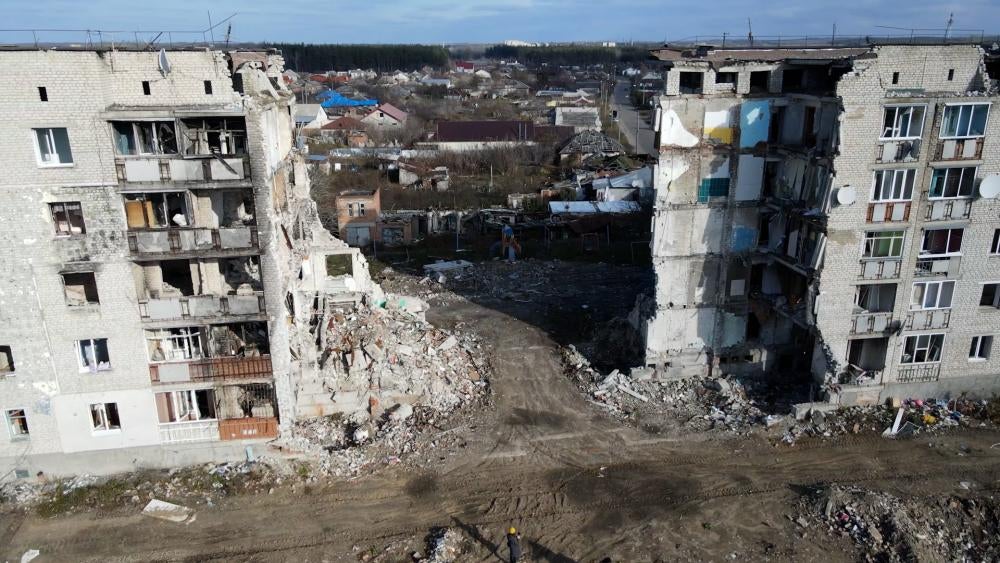Ukraine should investigate its military’s apparent use of thousands of rocket-fired antipersonnel landmines in and around the eastern city of Izium when Russian forces occupied the area, Human Rights Watch said today.
Human Rights Watch documented numerous cases in which rockets carrying PFM antipersonnel mines, also called “butterfly mines” or “petal mines,” were fired into Russian-occupied areas near Russian military facilities. Ukraine is a state party to the 1997 Mine Ban Treaty, which prohibits any use of antipersonnel mines.
“Ukrainian forces appear to have extensively scattered landmines around the Izium area, causing civilian casualties and posing an ongoing risk,” said Steve Goose, Arms Division director at Human Rights Watch. “Russian forces have repeatedly used antipersonnel mines and committed atrocities across the country, but this doesn’t justify Ukrainian use of these prohibited weapons.”
Human Rights Watch documented PFM mine use in nine different areas in and around Izium city and verified 11 civilian casualties from these mines.
In six of the nine areas, witnesses described attacks consistent with landmines delivered by rocket artillery. In three locations in the Izium area, Human Rights Watch saw how the rocket motor of an Uragan-series artillery rocket, which can be used for mine dispersal, was lodged in the ground or had hit a building in such a way that indicated it had come from the direction where Ukrainian forces controlled territory, and were within the 35-kilometer maximum range of these rockets, at the time of the attack.
More than 100 residents of Izium and the surrounding area said that Russian forces or occupation authorities posted and distributed flyers to warn of the landmine danger. They also cleared landmines from public areas and civilians’ private property and took some mine victims to Russia for medical care – actions inconsistent with being responsible for laying the mines. Human Rights Watch interviewed two landmine victims who said that Russian forces transferred them by military helicopter to Russia for medical care.
Human Rights Watch has documented Russia’s use of other kinds of antipersonnel mines in Ukraine but has not verified claims of Russian forces using PFM mines in the armed conflict.
The 1997 Mine Ban Treaty comprehensively bans antipersonnel mines and requires destruction of stocks, clearance of mined areas, and assistance to victims. Ukraine signed the Mine Ban Treaty on February 24, 1999, and ratified it on December 27, 2005. Russia has not joined the treaty, but it is still in violation of international law when using antipersonnel mines given their inherently indiscriminate nature. The Mine Ban Treaty entered into force on March 1, 1999, and its 164 states include all NATO member states, except the US, and all European Union member states.
On November 23, the Defense Ministry provided a written response, saying that the military abides by its international obligations, including the prohibition of the use of any antipersonnel mines, but without addressing any of the questions about PFM mine use in and around Izium, noting that “information on the types of weapons used by Ukraine ... is not to be commented on before the war ends.”
At the Mine Ban Treaty’s 20th Meeting of States Parties on November 24, 2022, Ukraine said it is a “responsible party” to the treaty and “never considered” using its antipersonnel mine stocks for defensive purposes.
Russian forces also controlled territory around Izium for the duration of the occupation from which they would have been able to fire rocket artillery from a minimum of 10 kilometers away and into areas occupied by its forces and Ukrainian civilians. However, a scenario in which Russia, repeatedly over the course of five months, used antipersonnel landmines against its own troops and across territory it hoped to control permanently is highly unlikely.
vk.com



 - szinten
- szinten















